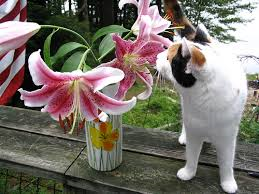 There are over 700 plants that could kill or injure your dog or cat! Some could well be growing in your yard right now. Keep your pet safe from eating poisonous plants inside and outside your home. Start with our list of common dangerous plants.
There are over 700 plants that could kill or injure your dog or cat! Some could well be growing in your yard right now. Keep your pet safe from eating poisonous plants inside and outside your home. Start with our list of common dangerous plants.
The list included here cannot possibly begin to cover every single poisonous plant in existence. Also, some of these plants are much more toxic than others. It is important to use your best judgment when determining whether or not these plants should remain in your home or garden. Consider your personal situation and the normal behavior of your pets. If you keep any of these plants in areas that cannot be accessed by your pet, or if you have a pet that has never bothered with getting into your plants in the past, then it is likely you shouldn’t have a problem with keeping those particular plants in a home with pets.
The most important thing for you do to when assessing your current plant situation is to dig a little bit deeper and find out exactly how toxic certain plants can be and how they can affect your animal.
The 10 Most Common Poisonous Plants:
Marijuana – Animals who attempt to snack on this plant can suffer serious consequences such as diarrhea, vomiting, increased heart rate, drooling, in-coordination, and even possibly seizures and coma.
Sago Palm – While the seeds and nuts of this plant are most poisonous, the entire plant is toxic. Animals ingesting parts of this plant may suffer from diarrhea, vomiting, depression, seizures and liver failure.
Lilies – Plants of the lily variety are very poisonous to cats. Even very small amounts of this plant could cause serious kidney damage.
Tulips – The toxic portion of this plant is the actual bulb, which can cause drooling, central nervous system depression, gastrointestinal irritation, cardiac issues and convulsions.
Azalea – The toxins in azalea plants can be very severe and potentially cause drooling, diarrhea, vomiting, central nervous system weakening and depression, and in some cases possibly coma or death.
Oleander – All portions of this plant are poisonous and can cause gastrointestinal irritation, hypothermia, heart problems and possibly death.
Castor Bean – Poisoning as a result of this plant can cause abdominal pain, drooling, diarrhea, vomiting increased thirst, loss of appetite and weakness. More serious cases could also lead to dehydration, tremors, seizures, twitching muscles, coma and possibly death.
Cyclamen – The most poisonous portion of this plant is located in the root. Ingestion of the plant can cause severe vomiting and gastrointestinal irritation. In some cases death has been reported as a result.
Kalanchoe – Ingestion of this plant can cause gastrointestinal irritation and cardiac rhythm and rate problems.
Yew – Poisoning as a result of the yew plant can affect the nervous system and cause in-coordination, trembling and breathing difficulties. It may also result in gastrointestinal irritation, cardiac failure and could possibly lead to death.
NOTE: If you suspect that your pet has been poisoned, contact the American Society for the Prevention of Cruelty to Animals (ASPCA) Poison Control Center at 1-888-426-4435. This is 24 hour a day hotline. (Note that in some cases a consultation fee may be charged to your credit card.)

Recent Comments